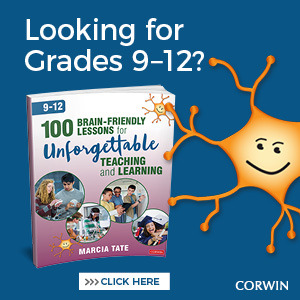100 Brain-Friendly Lessons for Unforgettable Teaching and Learning (K-8)
- Marcia L. Tate - Developing Minds, Inc.
Use research- and brain-based teaching to engage students and maximize learning
Lessons should be memorable and engaging. When they are, student achievement increases, behavior problems decrease, and teaching and learning are fun! In 100 Brain-Friendly Lessons for Unforgettable Teaching and Learning K-8, best-selling author and renowned educator and consultant Marcia Tate takes her bestselling Worksheets Don’t Grow Dendrites one step further by providing teachers with ready-to-use lesson plans that take advantage of the way that students really learn. Readers will find
- 100 cross-curricular sample lessons from each of the four major content areas: English/language arts, mathematics, science, and social studies.
- Plans designed around the most frequently taught objectives found in national and international curricula.
- Lessons educators can immediately replicate in their own classrooms or use to develop their own.
- 20 brain-compatible, research-based instructional strategies that work for all learners.
- Five questions that teachers should ask and answer when planning brain-compatible lessons and an in-depth explanation of each of the questions.
- Guidance on building relationships with students that enable them to learn at optimal levels.
It is a wonderful time to be a teacher! This hands-on resource will show you how to use what we know about educational neuroscience to transform your classroom into a place where success if accessible for all.
Free resources
Grades 3-5 Math Lesson 1: Multiplication
Use this lesson from 100 Brain-Friendly Lessons for Unforgettable Teaching and Learning, Grades K-8, by Marcia Tate, with your Grades 3-5 students to show them how to use repeated addition to calculate multiplication problems
Grades 3-5 ELA Lesson 1: Decoding Multisyllabic Words
Use this lesson from 100 Brain-Friendly Lessons for Unforgettable Teaching and Learning, Grades K-8, by Marcia Tate, with your students to help them decode multisyllabic words using commonly used affixes and roots and determine how these affixes change a word’s meaning.


